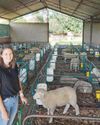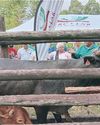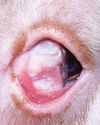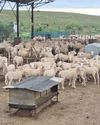Try GOLD - Free
Livestock's water requirements in intensive and extensive production systems
Stockfarm
|October 2025
The Earth's total water supply is estimated at around 1 386 million km³. However, only 2,5% of this comprises freshwater. Of that small fraction, approximately 68,7% is locked away in ice and snow formations in Antarctica, the Arctic, and mountainous regions.

Another 29,9% exists as groundwater, while only 0,26% is found as surface water in lakes, rivers, and dams. The remaining portion is distributed across soil moisture, swamps, and permanent ice (permafrost). Despite its fundamental role in sustaining life, freshwater remains a scarce resource. Dr Ockert Einkamerer, senior lecturer in the Department of Animal Science at the University of the Free State, says among the five essential nutrients - energy, protein, minerals, vitamins, and water - water is arguably the most critical for livestock.
Water in mother's milk
On average, an animal's milk contains 85 to 87% water, while the body itself consists of at least 65% water. No physiological function can occur without water, as it is the medium through which nutrients are transported via the blood. This is because water is chemically neutral, allowing for the easy ionisation of various substances.
Water also provides the environment for most chemical reactions in the body. It plays a vital role in maintaining osmotic balance and supports healthy rumen function, which is central to ruminant digestion. Microorganisms in the rumen need to move freely between nutrients, and sufficient water availability makes this possible, says Dr Einkamerer.
Water is essential for the excretion of waste products such as urine, manure, sweat, and even milk. It also plays a critical role in thermoregulation, helping animals control their body temperature. Cooling occurs through evaporation via the lungs, mouth, and sweat glands on the skin. Because water has a high latent heat of vaporisation, it is highly effective in cooling animals under hot, humid conditions. Access to clean, cool water in such environments is therefore vital in both extensive and intensive production systems.

This story is from the October 2025 edition of Stockfarm.
Subscribe to Magzter GOLD to access thousands of curated premium stories, and 10,000+ magazines and newspapers.
Already a subscriber? Sign In
MORE STORIES FROM Stockfarm
Stockfarm
Trust and muffins lead the way
In any business, communicating in silos is the main cause of issues among managers. With only three of us managing things, myself on sheep, Gert on vehicles and Mbali on payments, breaking through our silos is easy. Twice a week we hold short morning meetings to report progress and problems towards our goal of turning grass into sheep for profit.
2 mins
December 2025
Stockfarm
Santa's new team
Last December, we warned Santa Claus of the perils of visiting South Africa with his team of reindeer. We cautioned him about the biological hazards his reindeer might bring into the country, and the import tariff issues he might encounter when trying to bring in all those gifts. We also elaborated on the heat and other environmental challenges his team might face. But we also told him about our friendly farmers and the braais he might be invited to, complete with a beverage of his choice.
3 mins
December 2025

Stockfarm
The effect of iucerne hay quaiiiy on feedlot lambs
Lucerne hay is one of the most widely used roughage sources for ruminant diets, largely due to its reputation for providing high-quality nutrition. Important considerations for producers who use lucerne hay in their feed programme include assessing the true value of lucerne hay, determining the most suitable grade for specific feeding purposes, considering its cost, and balancing these factors against optimal feedlot performance.
3 mins
December 2025

Stockfarm
Imfuyo-yami Ingumcebo Wami: Livestock as a legacy of wealth and wisdom
In the heart of KwaZulu-Natal, under the warm sun and the watchful gaze of the rolling hills, the Hlawini Community Hall in Umfolozi Local Municipality came alive with the spirit of unity, learning, and tradition. The occasion? The Umfolozi Livestock Farmers' Information Day, held under the banner of the Agricultural Research Council's (ARC) Kaonafatso ya Dikgomo (KyD) project, a national an initiative aimed at empowering communal livestock farmers through knowledge, technology, and sustainable practices.
3 mins
December 2025

Stockfarm
Celebrating the 2025 Komga Agricultural Show
This year's Komga Agricultural Show, energised by the arrival of summer and filled with festive stalls, was a hive of activity. The grounds came alive with live music, a poultry exhibition, the familiar sounds of cattle and sheep in the pens, displays of horsemanship, and top-quality technology and implements on show.
2 mins
December 2025
Stockfarm
DSA reaches new milestone on the road to excellence
The Dairy Standard Agency (DSA) has enjoyed an exceptional 2025 so far, marking two major achievements that underscore its ongoing pursuit of excellence.
3 mins
December 2025
Stockfarm
Samic: Protector of red meat quality
If you thought the South African Meat Industry Company (Samic) is just about carcass competitions, think again. Fact is, the company plays a pivotal role in South Africa's meat supply chain, upholding rigorous standards of quality, safety, and transparency from the farm gate to the plate.
3 mins
December 2025

Stockfarm
Wireworm management in small stock
Years of indiscriminate dosing have eliminated weaker wireworms, allowing resistant populations to dominate and spread through flocks. Wireworms typically hatch following good rains and warm nights. When larvae move up the green grass, they are ingested by grazing sheep. About 20 days later, the worms begin sucking blood, leading to anaemia and, in severe cases, death.
2 mins
December 2025

Stockfarm
Back to basics at the 2025 LRF Stockman School
The 17th Annual LRF Stockman School, hosted by the Livestock Registering Federation (LRF), kicked off with great enthusiasm at the Aldam Holiday Resort and Conference Centre in the Free State. Held over three days, the event brought together leading experts from a range of fields who met everyone's expectations by addressing relevant and timely topics head-on.
7 mins
December 2025

Stockfarm
Vertical gains in the lambing pen: It's not just about the numbers
In a world where rising input costs and increasing consumer demands play a decisive role, it has become more important than ever for red meat producers to raise lambs that not only benefit the producer but also add value throughout the entire supply chain.
4 mins
December 2025
Listen
Translate
Change font size
